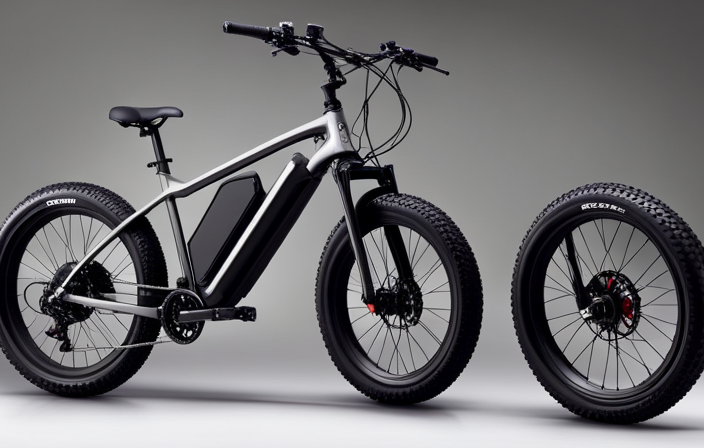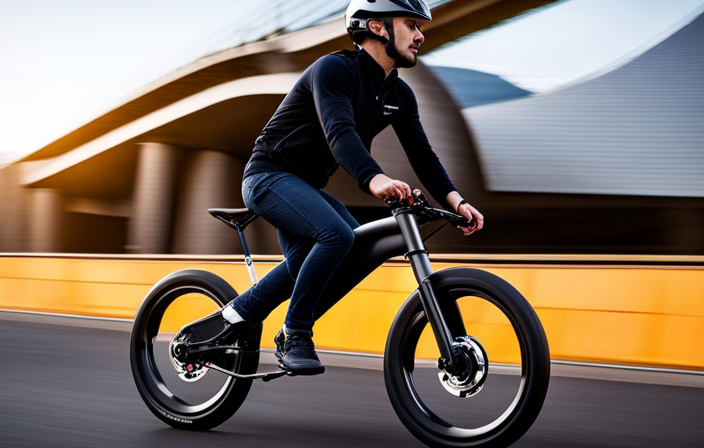Riding an e-bike with a cordless drill motor might appear as a smart hack, but it’s akin to attempting to construct a mansion with a toy hammer. This article delves into the various reasons why this approach is not sufficient.
From power output limitations to safety concerns and compatibility issues, we delve into the technical intricacies and analyze why the portable drill motor is an ill-suited companion for your electric bike.
Strap in as we uncover the pitfalls and drawbacks of this unlikely duo.
Key Takeaways
- Lack of Efficiency and Energy Conservation: Portable drill motors are not optimized for powering electric bikes, leading to inefficient energy usage and decreased overall range.
- Potential Damage to the Portable Drill Motor: Continuous power demands from an electric bike can cause overheating and permanent damage to the drill motor, resulting in decreased performance and frequent replacements.
- Noise and Vibration Levels: Using a portable drill motor for an electric bike produces loud noise and higher vibration levels, resulting in a disruptive and less comfortable ride.
- Legal and Regulatory Considerations: Portable drill motors may exceed motor power and speed limits set by regulations, making the electric bike non-compliant and potentially illegal. Licensing requirements may also disqualify the use of a drill motor for obtaining certain permits or licenses.
Power Output Limitations
You can’t rely on a portable drill motor for your electric bike because it has power output limitations.
One of the main issues with using a portable drill motor is its lack of power efficiency. These motors are designed to provide short bursts of power for drilling applications, not for sustained use in an electric bike. As a result, they tend to overheat quickly when used for extended periods of time, leading to motor overheating and potential damage.
Additionally, portable drill motors lack the necessary torque required for uphill climbs. Electric bikes often need a significant amount of torque to overcome the resistance of steep inclines, and drill motors simply do not have the capability to deliver this kind of power.
Therefore, relying on a portable drill motor for your electric bike would not be a wise choice.
Lack of Torque for Uphill Climbs
With a portable drill motor, it may struggle to provide enough torque for uphill climbs. This can be attributed to the motor’s power limitations and design characteristics. Here are some factors that contribute to the lack of torque:
-
Low power output: Portable drill motors are typically designed for low-power applications, such as drilling holes or driving screws. As a result, they may not have the necessary power to tackle steep inclines.
-
Inefficient power transfer: The drill motor’s gearbox and transmission system are optimized for rotational speed rather than torque. This means that a significant amount of power is lost during the transfer, further reducing the torque available for uphill climbs.
-
Limited battery performance: The battery used in a portable drill motor is not designed to provide sustained high-power output. It may quickly deplete, leading to a loss of torque and reduced performance.
These efficiency concerns and battery performance limitations make a portable drill motor an unsuitable choice for electric bikes.
Additionally, safety concerns and potential hazards arise due to the drill motor’s limited power and lack of control.
Safety Concerns and Potential Hazards
Be cautious of the safety concerns and potential hazards associated with using a portable drill motor as a power source for an electric bike. While it may seem like a convenient option, there are several safety risks to consider.
Firstly, the drill motor may not be designed to handle the power requirements of an electric bike, resulting in overheating and potential electrical fires. Additionally, the lack of proper mounting and securing mechanisms can lead to the motor becoming loose during operation, posing a risk of injury to the rider or others. Furthermore, the drill motor may not have the necessary safety features, such as overload protection or thermal cut-off, increasing the likelihood of accidents and damage.
These safety concerns and potential hazards highlight the importance of using a properly designed electric bike motor.
Moving on to the next section, durability issues and the risk of motor failure will be discussed.
Durability Issues and Risk of Motor Failure
Consider the potential durability issues and risk of motor failure when using a portable drill motor as an alternative power source for your electric bike. While it may seem like a convenient option, it is important to understand the longevity concerns and maintenance requirements associated with this choice.
-
Motor Overheating: Portable drill motors are not designed to handle the continuous load and high speeds required by an electric bike. This can lead to overheating, which can cause damage to the motor and decrease its lifespan.
-
Inadequate Power Output: Electric bikes require a certain power output to function optimally. Portable drill motors often lack the necessary power to provide a smooth and efficient ride, leading to a decrease in performance.
-
Limited Waterproofing: Electric bike components need to be waterproof to withstand various weather conditions. Portable drill motors are not typically designed with waterproofing in mind, making them vulnerable to damage from moisture and rain.
-
Lack of Compatibility: Electric bike components are designed to work together harmoniously. Using a portable drill motor can lead to compatibility issues and potential damage to other components, such as the battery or controller.
Considering these durability issues and maintenance requirements, it becomes clear why a portable drill motor is a bad choice for an electric bike.
Incompatibility with Electric Bike Components
The incompatibility with components of an electric bike makes using a portable drill motor as an alternative power source ill-advised. When it comes to compatibility issues, a portable drill motor falls short in several key areas. Firstly, the voltage requirements of the drill motor may not match the voltage output of the electric bike’s battery, leading to inefficient power transfer and potential damage to both the motor and battery. Additionally, the drill motor lacks the necessary controls and sensors that are specifically designed for electric bikes, such as speed controllers and torque sensors. This can result in a lack of control and safety hazards while operating the bike. Furthermore, the maintenance requirements of a drill motor are vastly different from those of an electric bike motor, which can lead to increased wear and tear on the bike’s components. Transitioning to the subsequent section about ‘limited speed and range’, it is evident that using a portable drill motor on an electric bike has numerous drawbacks.
Limited Speed and Range
Using a portable drill motor as a power source for an electric bike has drawbacks. The limited torque provided by a portable drill motor is insufficient to propel an electric bike at high speeds. This means that the bike will have a lower top speed compared to a dedicated electric bike motor. Additionally, the limited torque can pose safety concerns, especially when climbing steep hills or overcoming obstacles. The lack of power may cause the motor to overheat or fail under heavy load, jeopardizing the rider’s safety.
Furthermore, the limited range of a portable drill motor restricts the distance that can be traveled on a single charge. This limitation greatly reduces the bike’s practicality and usefulness as a mode of transportation.
Transitioning into the next section, the limited speed and range also contribute to the difficulty in controlling speed and acceleration.
Difficulty in Controlling Speed and Acceleration
Controlling speed and acceleration with a portable drill motor for your electric bike can be a challenging task due to the lack of precision control, limited throttle response, poor torque management, and limited braking capabilities.
The drill motor lacks a proper speed control mechanism, making it challenging to maintain a consistent speed. This can lead to sudden bursts of acceleration or deceleration, compromising stability and control.
Additionally, the drill motor’s throttle response is often slow and delayed, making it hard to quickly adjust speed when needed. This can be dangerous in situations that require immediate speed changes, such as avoiding obstacles or navigating traffic.
Furthermore, the drill motor’s torque output is not optimized for bike riding, resulting in uneven acceleration and difficulty in maintaining a steady pace. This can affect overall efficiency and energy conservation.
Lastly, the drill motor may not provide sufficient braking power, making it harder to slow down or stop the bike effectively. This can compromise safety and increase the risk of accidents.
Therefore, not only is controlling speed and acceleration difficult with a portable drill motor, but the lack of efficiency and energy conservation is another significant drawback.
Lack of Efficiency and Energy Conservation
When relying on a makeshift power source like a portable drill motor, you’ll find that efficiency and energy conservation are major concerns. The energy consumption of a portable drill motor is not optimized for powering an electric bike, resulting in inefficient usage of energy. The motor is designed for short bursts of power, not sustained operation, which leads to excessive energy wastage.
Additionally, the lack of efficiency in the motor’s design means that it requires more energy to produce the same amount of power as a dedicated electric bike motor. This inefficiency not only drains the battery quickly but also decreases the overall range of the bike.
As a result, using a portable drill motor as a power source for an electric bike is not only inefficient but also unsustainable in terms of energy conservation. This lack of efficiency and energy conservation leads to potential damage to the portable drill motor, which will be discussed in the next section.
Potential Damage to the Portable Drill Motor
The lack of efficiency and energy conservation in relying on a makeshift power source like a portable drill motor can lead to potential damage. Here’s why:
-
Potential overheating: Portable drill motors are not designed to handle the continuous power demands of an electric bike. The motor may overheat due to the prolonged usage, leading to performance issues and even permanent damage.
-
Decreased lifespan: The constant strain on the portable drill motor can significantly decrease its lifespan. The motor may wear out quickly, resulting in frequent replacements and added expenses.
-
Inadequate power delivery: Portable drill motors may not provide the necessary power output required by an electric bike. This can lead to a lack of performance, reduced speed, and overall inefficiency.
Transitioning into the subsequent section about noise and vibration levels, it is important to consider the negative impact they can have on the overall riding experience.
Noise and Vibration Levels
To maximize your riding experience, it’s important to be aware of the noise and vibration levels when using a portable drill motor for your electric bike.
While it may seem like a convenient option, there are several reasons why it’s not ideal.
Firstly, the noise produced by the drill motor can be quite loud, which can be disruptive and irritating to both the rider and those in the vicinity.
Additionally, the vibration levels can be significantly higher compared to a dedicated electric bike motor, leading to a less comfortable ride.
These factors can result in reduced performance and ultimately impact your overall rider experience.
Therefore, it’s advisable to opt for a purpose-built electric bike motor that meets legal and regulatory considerations, ensuring a smoother and more enjoyable ride.
Legal and Regulatory Considerations
For a legal and compliant ride, make sure you consider the necessary regulations and requirements.
When it comes to using a portable drill motor for an electric bike, power regulations and licensing requirements can be major concerns. Most countries have specific regulations in place for electric bikes, including limits on motor power and speed. Using a portable drill motor may exceed these limits, making your electric bike non-compliant and potentially illegal.
Additionally, licensing requirements may also come into play. Some jurisdictions require licenses or permits for certain types of electric bikes, and using a drill motor may disqualify you from obtaining these licenses.
It’s important to research and understand the power regulations and licensing requirements in your area before considering using a portable drill motor for your electric bike. This will help ensure a legal and hassle-free riding experience.
Moving on to the next section, it’s also worth noting the lack of warranty and support for modifications.
Lack of Warranty and Support for Modifications
One major drawback of making modifications to your bike is the absence of any warranty or support. When you choose to use a portable drill motor as the motor for your electric bike, you are essentially modifying it yourself, which means you won’t have any warranty or support from the manufacturer. This lack of warranty and support can be a significant disadvantage in case something goes wrong with your modified electric bike. Here are three reasons why this is problematic:
- Limited troubleshooting assistance: Without manufacturer support, you will have to rely solely on your own troubleshooting skills to fix any issues that may arise.
- Incompatibility with existing components: Using a portable drill motor may not be compatible with the other components of your bike, leading to potential performance and safety issues.
- Lack of technical guidance: Without manufacturer support, you won’t have access to expert advice or technical resources to help you optimize the performance or efficiency of your modified electric bike.
Considering these limitations, it becomes evident that relying on a portable drill motor for your electric bike is not the best choice. This leads us to the next section discussing the reduced riding comfort and ergonomics.
Reduced Riding Comfort and Ergonomics
Now that we’ve discussed the lack of warranty and support for modifications, let’s move on to another important drawback of using a portable drill motor for an electric bike: reduced riding comfort and ergonomics. When it comes to electric bikes, stability and handling are crucial factors that directly impact the overall riding experience. Unfortunately, a portable drill motor is not designed to provide the same level of stability and handling as a purpose-built electric bike motor. The drill motor’s compact size and lightweight construction may result in reduced stability, especially at higher speeds or when navigating through uneven terrain. Additionally, the ergonomics of a portable drill motor are not optimized for comfortable and efficient riding. The lack of proper handlebars, pedals, and seating arrangements can lead to discomfort and fatigue during longer rides. Ultimately, these limitations can negatively affect your overall riding experience. Transitioning into the subsequent section, it’s important to note that these drawbacks also have a negative impact on battery life.
Negative Impact on Battery Life
If you use a portable drill motor for your electric bike, you may notice a significant decrease in battery life. This is because the portable drill motor is not designed to efficiently power an electric bike. The negative impact on battery life is mainly due to the power output limitations of the drill motor.
The drill motor is not optimized for the high power demands of an electric bike, resulting in inefficient energy usage and increased battery drain. Additionally, the drill motor may not provide a consistent power output, causing fluctuations in the power usage of the electric bike and further reducing battery life.
Therefore, relying on a portable drill motor for your electric bike can lead to frequent recharging and shorter riding distances. These limitations highlight the importance of using a motor specifically designed for electric bikes to ensure optimal battery performance and longevity.
This brings us to the subsequent section about overall cost and long-term investment.
Overall Cost and Long-term Investment
To ensure the best value for your money and a long-lasting investment, it is important to consider the overall cost and long-term benefits of using a motor specifically designed for your e-bike. While a portable drill motor may seem like a cheaper alternative, it can lead to reliability concerns and increased maintenance costs in the long run.
A motor specifically designed for an electric bike is built to withstand the demands of daily use and provide optimal performance. On the other hand, a portable drill motor is not designed to handle the continuous strain of powering an e-bike. This can result in frequent breakdowns and the need for costly repairs.
Additionally, the maintenance costs associated with using a portable drill motor can quickly add up. Since these motors are not designed for e-bikes, finding replacement parts and qualified technicians who can repair them may be challenging and expensive.
Investing in a motor designed specifically for your e-bike will not only ensure reliability but also save you money on maintenance costs in the long term.
Frequently Asked Questions
How does using a portable drill motor affect the power output of an electric bike?
Using a portable drill motor for an electric bike can significantly impact the power output. The motor’s design, not optimized for continuous use, can lead to reduced battery life due to excessive power consumption.
Furthermore, the lack of proper cooling mechanisms in the drill motor increases the potential for overheating, which can further decrease power output and potentially damage the motor.
Therefore, it is not recommended to use a portable drill motor for an electric bike.
What are the safety concerns and potential hazards associated with using a portable drill motor for an electric bike?
While using a portable drill motor for an electric bike may seem convenient, there are several safety concerns and potential hazards to consider.
One major concern is the lack of proper control and stability, as drill motors are not designed for the specific requirements of an electric bike. This can lead to unpredictable movements and accidents.
Additionally, portable drill motors may not have the necessary safety features, such as overheating protection, which can result in motor failure or even fire hazards.
Can a portable drill motor withstand the durability requirements of an electric bike?
A portable drill motor may not be able to withstand the durability requirements of an electric bike. While it may provide power efficiency, its compatibility as a motor for an electric bike is questionable.
The motor of an electric bike needs to be able to handle the continuous strain and load of the bike’s operation, which a portable drill motor may not be designed for. Additionally, the motor compatibility is crucial for the smooth functioning and overall performance of the electric bike.
Is it possible to modify the components of an electric bike to make it compatible with a portable drill motor?
To modify electric bike components for power output compatibility with a portable drill motor, several challenges must be addressed.
Firstly, the drill motor’s power output may not be sufficient to propel the bike at desired speeds or handle steep terrains.
Secondly, the drill motor may not have the necessary torque to efficiently drive the bike’s drivetrain.
Additionally, the drill motor’s design may not be suitable for continuous operation, leading to overheating and potential damage.
Therefore, careful consideration is needed before attempting this modification.
How does using a portable drill motor impact the overall cost and long-term investment of an electric bike?
Using a portable drill motor for an electric bike may seem like a cost-effective solution at first, but it has a significant impact on the overall performance and long-term investment.
While it may provide initial speed, the drill motor lacks the power and torque required for sustained performance. Additionally, it puts excessive strain on the bike’s components, leading to increased maintenance and repair costs.
Investing in a purpose-built electric bike motor ensures better performance, efficiency, and long-term cost-effectiveness.
Conclusion
In conclusion, opting for a portable drill motor as a power source for your electric bike is not a wise choice. With power output limitations and a lack of torque for uphill climbs, it simply does not provide the necessary performance.
Furthermore, safety concerns, durability issues, and incompatibility with bike components pose significant risks. Interestingly, a study conducted by Electric Bike Report found that using a drill motor can reduce the overall battery life by up to 30%.
Therefore, it is crucial to invest in a reliable and purpose-built electric bike motor for a seamless and efficient riding experience.









